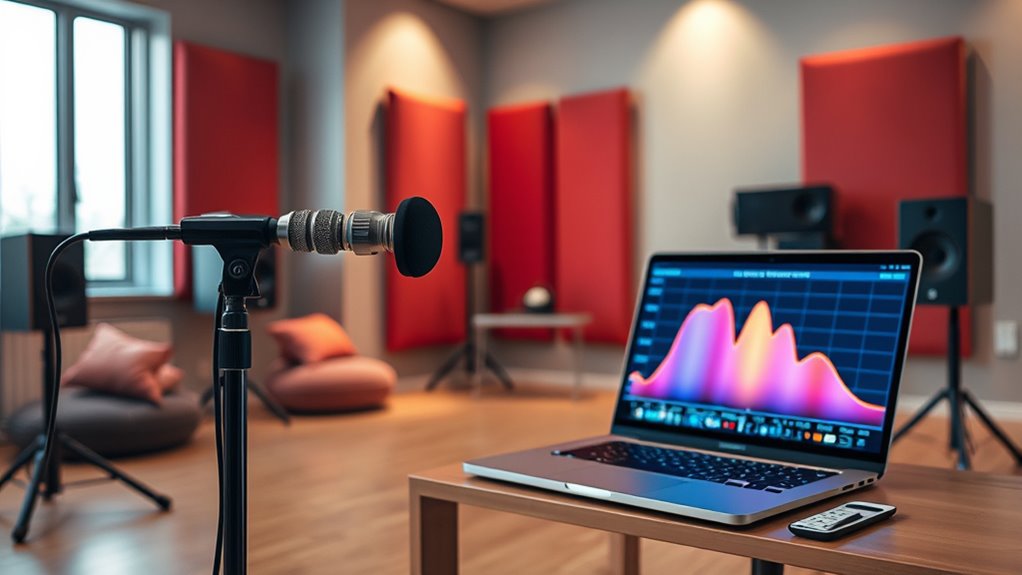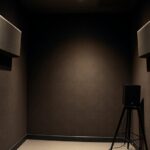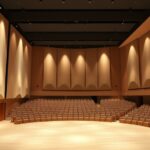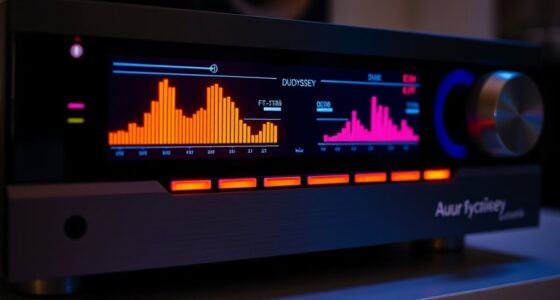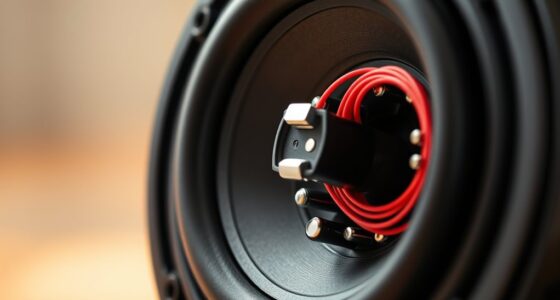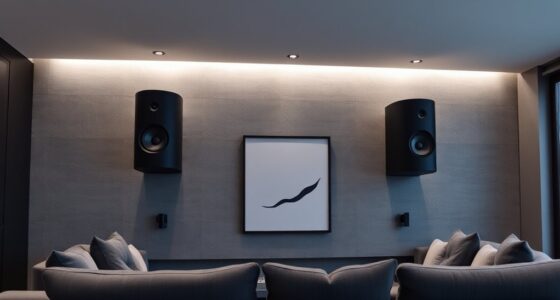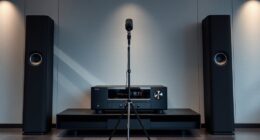To measure and correct room modes, start by using a microphone and room analysis software to identify resonances that cause bass peaks and dips. Once you pinpoint problem frequencies, you can adjust speaker placement or add acoustic treatments like bass traps and diffusers to reduce these resonances. Electronic EQ can also fine-tune the response. Continuing to explore how to combine these methods will help you optimize your listening environment and achieve balanced sound.
Key Takeaways
- Measure room response with a microphone and software to identify frequency peaks and dips caused by room modes.
- Use measurements to locate problematic resonances and determine whether they are related to room dimensions or shape.
- Apply physical acoustic treatments, like bass traps and diffusers, to absorb or scatter problematic frequencies.
- Utilize equalization (EQ) to target and reduce specific peaks or dips in the frequency spectrum.
- Continuously monitor and adjust placement, treatments, and EQ settings for optimal correction of room modes.
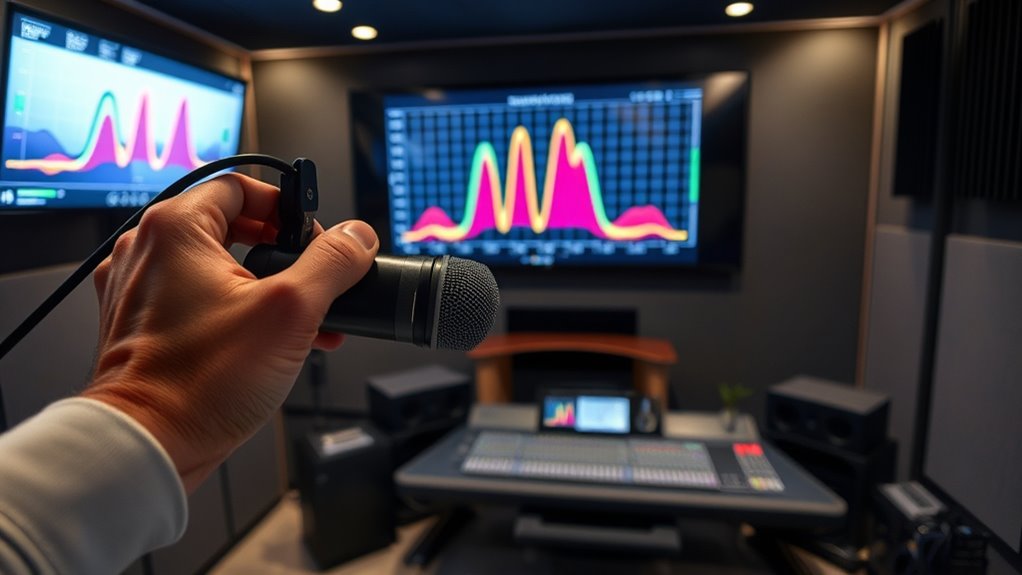
Have you ever wondered why your home audio or theater system doesn’t sound as good as it should? One common reason is the way your room interacts with your speakers and how sound waves behave within that space. When you set up your system, the positioning of your speakers—known as speaker placement—plays a vital role in achieving balanced sound. Proper placement helps minimize reflections and standing waves, which can cause certain frequencies to be overly loud or quiet. For example, placing speakers too close to walls or corners can amplify bass frequencies, creating boomy, uneven sound. Moving them slightly away from walls and experimenting with angles can help reduce these issues markedly. But even with perfect placement, room modes—specific resonances caused by the size and shape of your room—can still cause peaks and dips in your sound response.
That’s where acoustic treatment comes into play. Acoustic treatments, like bass traps, diffusers, and absorbers, help control sound reflections and reduce the impact of problematic room modes. Installing bass traps in corners can absorb low-frequency resonances, smoothing out bass response. Diffusers scatter sound waves, preventing reflections from bouncing directly back to your ears and creating a more natural sound. Absorptive panels on walls can also lessen flutter echoes and reduce harshness in high frequencies. These treatments work together to create a more even sound field, but to fine-tune your system further, measuring your room’s acoustics is essential.
Using room EQ techniques allows you to identify problematic frequencies caused by room modes. By measuring your room with a microphone and software, you can see where peaks and dips occur across the frequency spectrum. Once you have this data, you can make targeted adjustments—either physically by repositioning speakers and adding acoustic treatments or electronically through equalization settings. Modern room EQ systems analyze the room’s behavior in real-time, helping you correct these issues swiftly and effectively. This process transforms a space with uneven sound into a balanced, immersive listening environment. Remember, the combination of proper speaker placement, strategic acoustic treatment, and accurate measurement guarantees you get the best possible sound from your setup. It’s not just about high-end equipment but understanding how your room influences sound and taking steps to optimize it. When you address these factors, you’ll hear clearer vocals, tighter bass, and a more natural overall sound that truly enhances your listening experience. Additionally, understanding Kia Tuning options can help optimize vehicle audio systems for better sound quality while on the road.
Frequently Asked Questions
How Do Room Modes Affect Different Types of Audio Equipment?
Room modes considerably affect different types of audio equipment by causing uneven bass response and muddiness. You can improve sound by carefully adjusting speaker placement, avoiding corners or reflective surfaces, which can amplify problematic modes. Proper positioning helps balance bass response across your equipment, whether it’s a subwoofer or full-range speakers. This reduces resonances and creates clearer, more accurate sound, ensuring your gear performs at its best in your space.
Can DIY Room Correction Solutions Match Professional Setups?
Think of DIY room correction solutions as brave little explorers venturing into a vast, professional jungle. While they can mimic some tools and techniques, they often fall short of the precision and finesse professional setups offer. DIY solutions can improve your sound, but if you crave perfection, investing in professional gear guarantees your audio landscape is a finely tuned symphony, not a wild, untamed wilderness.
What Are the Costs Associated With Advanced Room EQ Systems?
The costs for advanced room EQ systems vary based on the equipment investment you choose, with a thorough cost analysis revealing prices from a few hundred to several thousand dollars. You’ll need high-quality measurement microphones, calibration software, and digital processors. While professional-grade systems demand significant investment, they deliver precise room correction. Budget-conscious options exist, but verify they meet your needs for effective sound correction and long-term performance.
How Often Should Room Measurements Be Recalibrated?
You might think once you’ve done your room calibration, you’re set for life—think again. Measurement frequency depends on how often you tweak your setup or notice sound changes, but generally, recalibrate every 6 to 12 months. Changes in furniture, room layout, or even seasonal humidity can affect your sound, so don’t skip regular measurement checks. Keep your audio pristine by staying proactive with your room calibration schedule.
Are There Specific Room Shapes That Minimize Problematic Modes?
Certain room shapes, like rectangular or square designs, tend to have more problematic modes due to their symmetry. To minimize issues, opt for irregular or asymmetric room shapes, which disrupt standing wave patterns. Good acoustic design also involves adding diffusers and absorbers to control reflections. These measures help reduce resonances and improve sound clarity, ensuring your room’s acoustics stay balanced and enjoyable.
Conclusion
Just like a skilled sailor adjusts their sails to navigate choppy waters, you can fine-tune your room’s acoustics to achieve smooth, balanced sound. By measuring and correcting room modes, you prevent standing waves from turning your listening space into a turbulent sea. With these tools, you’ll transform your room into a serene harbor where every note flows effortlessly, letting your music or movies truly shine—making every listening experience a peaceful voyage.
